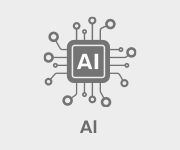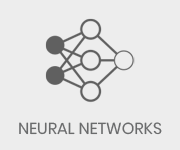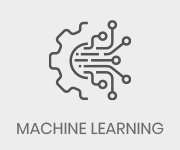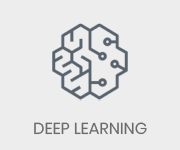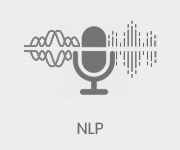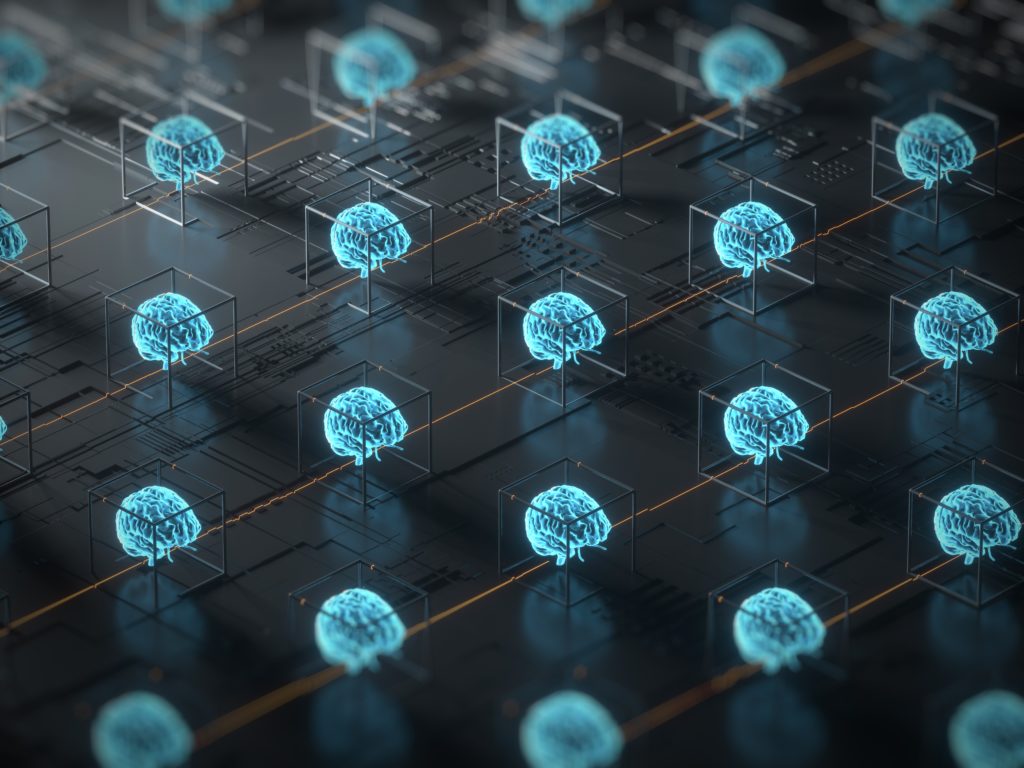
DATA SCIENCE & MACHINE LEARNING
Build and scale AI models with trust and transparency. Speed time to better AI outcomes with data science tools.
What Is Machine Learning?
Machine learning is a form of AI that enables a system to learn from data rather than through explicit programming. However, machine learning is not a simple process. As the algorithms ingest training data, it is then possible to produce more precise models based on that data.
A machine-learning model is the output generated when you train your machine-learning algorithm with data. After training, when you provide a model with an input, you will be given an output. For example, a predictive algorithm will create a predictive model. Then, when you provide the predictive model with data, you will receive a prediction based on the data that trained the model.
Iterative learning
Machine-learning techniques are required to improve the accuracy of predictive models. Depending on the nature of the business problem being addressed, there are different approaches based on the type and volume of the data. In this section, we discuss the categories of machine learning.
Supervised learning
Supervised learning typically begins with an established set of data and a certain understanding of how that data is classified. Supervised learning is intended to find patterns in data that can be applied to an analytics process. This data has labeled features that define the meaning of data. For example, you can create a machine-learning application that distinguishes between millions of animals, based onimages and written descriptions.
Unsupervised learning
Unsupervised learning is used when the problem requires a massive amount of unlabeled data. For example, social media applications, such as Twitter, Instagram and Snapchat, all have large amounts of unlabeled data. Understanding the meaning behind this data requires algorithms that classify the data based on the patterns or clusters it finds.
Unsupervised learning conducts an iterative process, analyzing data without human intervention. It is used with email spam-detecting technology. There are far too many variables in legitimate and spam emails for an analyst to tag unsolicited bulk email. Instead, machine-learning classifiers, based on clustering and association, are applied to identify unwanted email.
Reinforcement learning
Reinforcement learning is a behavioral learning model. The algorithm receives feedback from the data analysis, guiding the user to the best outcome. Reinforcement learning differs from other types of supervised learning, because the system isn’t trained with the sample data set. Rather, the system learns through trial and error. Therefore, a sequence of successful decisions will result in the process being reinforced, because it best solves the problem at hand.
Deep learning
Deep learning is a specific method of machine learning that incorporates neural networks in successive layers to learn from data in an iterative manner. Deep learning is especially useful when you’re trying to learn patterns from unstructured data.
Deep learning complex neural networks are designed to emulate how the human brain works, so computers can be trained to deal with poorly defined abstractions and problems. The average five-year-old child can easily recognize the difference between his teacher’s face and the face of the crossing guard. In contrast, the computer must do a lot of work to figure out who is who. Neural networks and deep learning are often used in image recognition, speech, and computer vision applications.
Approaches to machine learning
Machine learning enables models to train on data sets before being deployed. Some machine- learning models are online and continuous. This iterative process of online models leads to an improvement in the types of associations made between data elements. Due to their complexity and size, these patterns and associations could have easily been overlooked by human observation.
After a model has been trained, it can be used in real time to learn from data. The improvements in accuracy are a result of the training process and automation that are part of machine learning.
Big data in context of machine learning
Machine learning requires that the right set of data be applied to a learning process. An organization does not have to have big data to use machine-learning techniques; however, big data can help improve the accuracy of machine-learning models. With big data, it is now possible to virtualize data so it can be stored in the most efficient and cost-effective manner, whether on-premises or in the cloud.
Improvements in network speed and reliability have removed other physical limitations associated with managing massive amounts of data at the acceptable speed. Add to this the impact of changes in the price and sophistication of computer memory and it’s now possible to imagine how companies can leverage data in ways that would have been inconceivable only five years ago.
Applying machine learning to business needs
Machine learning offers potential value to companies trying to leverage big data and helps them better understand subtle changes in behavior, preferences or customer satisfaction. Business leaders are beginning to appreciate that many things happening within their organizations and industries can’t be understood through a query. It isn’t the questions that you know; it’s the hidden patterns and anomalies buried in the data that can help or hurt you.
How it all comes together
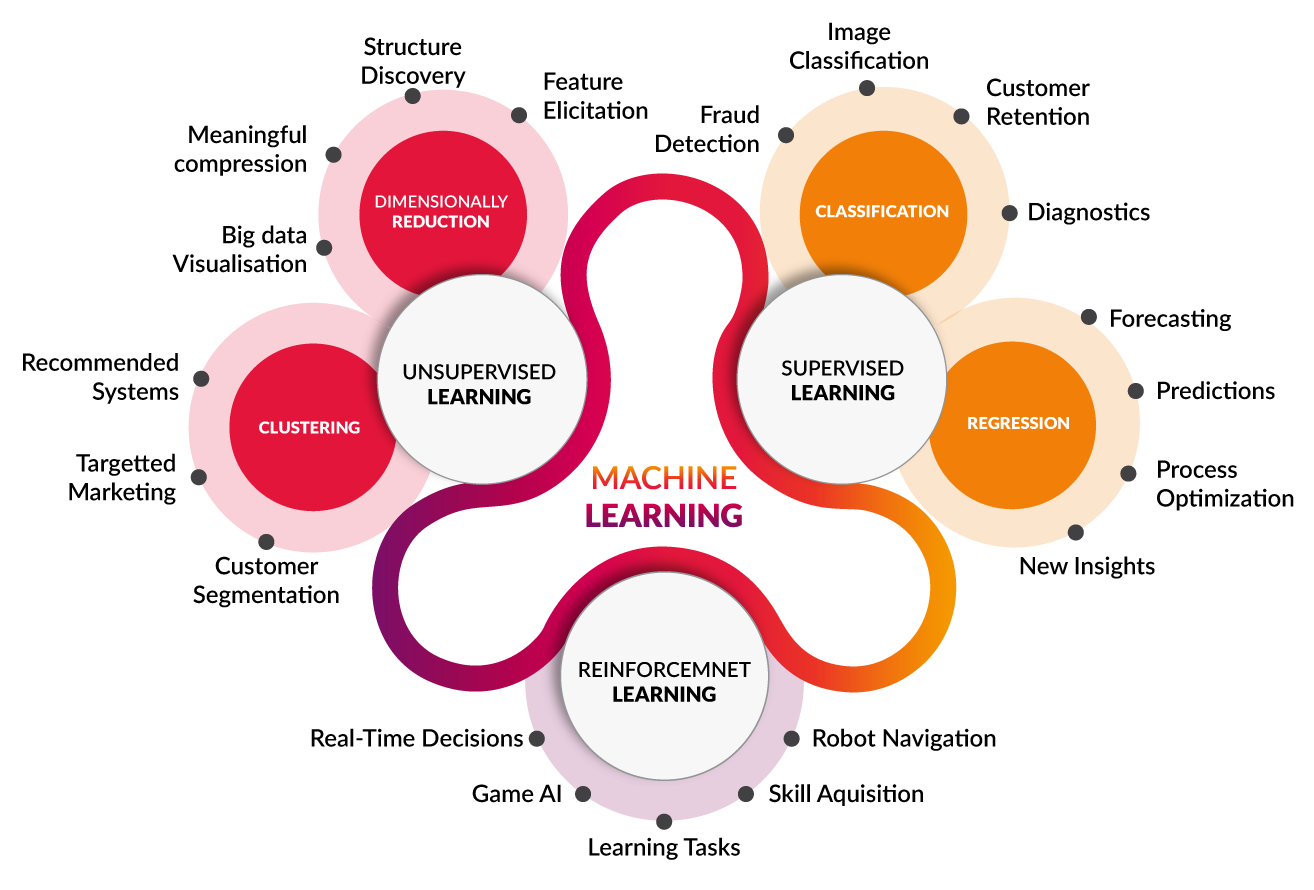
The advantage of machine learning is that it is possible to use algorithms and models to predict outcomes. The data scientists doing the work must ensure they are using the right algorithms, ingesting the most appropriate data (that is accurate and clean) and using the best performing models.
If all these elements come together it’s possible to continuously train the model and learn from the outcomes by learning from the data. The automation of this process of modeling, training the model and testing leads to accurate predictions to support business change.
MACHINE LEARNING, DEEP LEARNING & NEURAL NETWORKS
Run machine-learning models anywhere, across any cloud. Bring your open source AI projects into production.
EMPOWERING ANALYSTS WITH AI
Snowflake and DataRobot enable users of all skill levels to build, train, deploy, and manage highly accurate data science models in less time, turning more of their raw data into valuable business insights.
Adopters of automated machine learning (ML) tout unprecedented speed to insight and staggering returns on investment. According to McKinsey Insights, power users of AI can boost profits by one to five percentage points above industry averages.
Data represents a significant opportunity today, but it also requires the right analytical capabilities to extract the most value with AI.
Deeper insights from AI can generate revenue, spur innovation, cut costs, improve operations, and provide a competitive advantage. By using Snowflake with DataRobot, organizations can rapidly capitalize on their data’s untapped value.

MODERN CLOUD ARCHITECTURES
Snowflake Cloud Data Platform and DataRobot offer cloud scale and instant elasticity on the global cloud services of your choice: AWS, GCP, and Azure.

PURPOSE-BUILT INTEGRATIONS
Direct read and write integrations connect Snowflake and DataRobot seamlessly to enable all of your data prep and machine learning needs.

SCALABLE PERFORMANCE FOR ADVANCED ANALYTICS
Dedicated virtual warehouses on Snowflake allow your entire data science team to simultaneously explore and analyze all your data without bottlenecks.

DEDICATED ML SANDBOX FOR EVERY USER
With Snowflake Zero-Copy Cloning, users can conduct destructive testing within individual sandboxes using corporate data, without affecting other users or creating additional copies of data.

THE LEADER IN AUTOML
DataRobot automates the best practices of the world’s top data scientists by selecting the most accurate models from a library of hundreds of the most powerful open-source ML algorithms.

ACTIONABLE INSIGHTS IN MINUTES
With just a few clicks, users can generate an API and deploy their models. DataRobot replaces the manual work required by traditional data science processes, empowering teams of any skill level to build, deploy, and maintain models at scale.
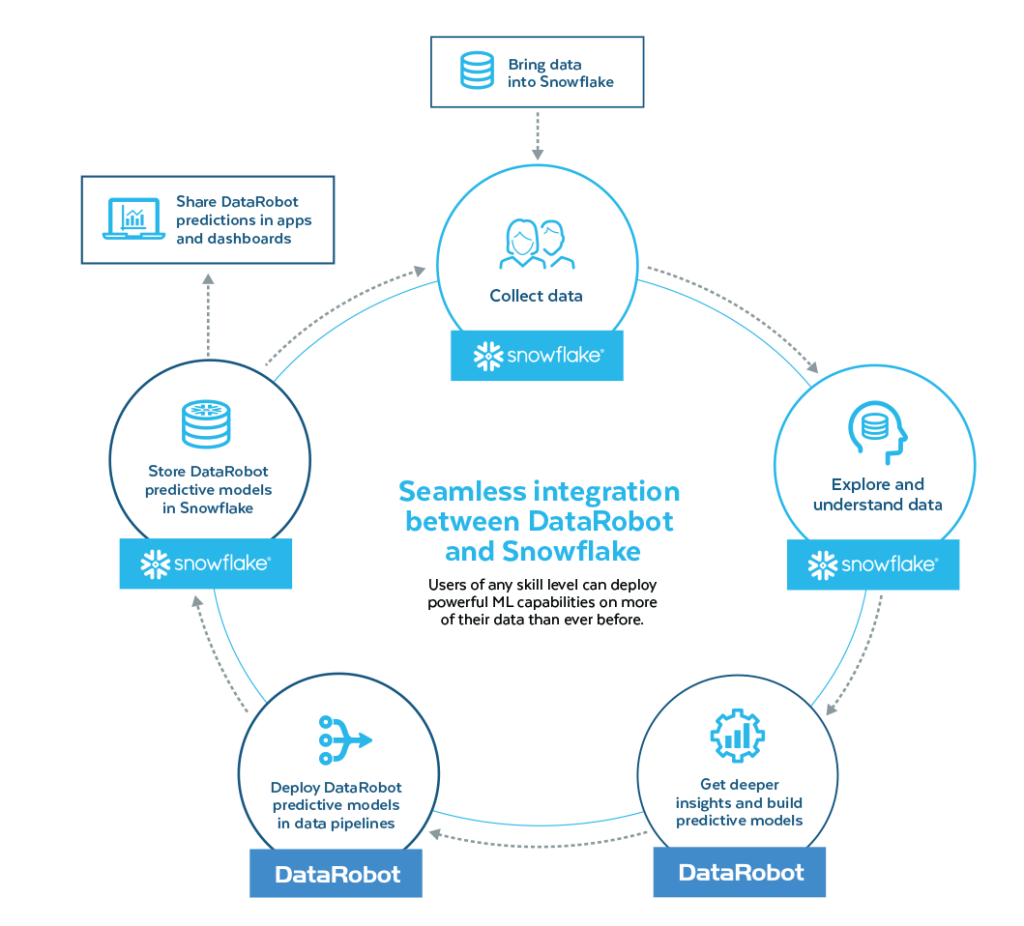
With the seamless bidirectional integration between Snowflake and DataRobot, users can read data in Snowflake, create predictions in DataRobot, and send decisions back to Snowflake removing the need for scripts and technical development. This allows users of any skill level to deploy powerful ML capabilities on more of their data than ever before with just a few clicks.
EMPOWERING ANALYSTS WITH AI
Adopters of automated machine learning (ML) tout unprecedented speed to insight and staggering returns on investment. According to McKinsey Insights, power users of AI can boost profits by one to five percentage points above industry averages.
Data represents a significant opportunity today, but it also requires the right analytical capabilities to extract the most value with AI.
Deeper insights from AI can generate revenue, spur innovation, cut costs, improve operations, and provide a competitive advantage. By using Snowflake with DataRobot, organizations can rapidly capitalize on their data’s untapped value.
DELIVERING DATA SCIENCE WITH DATAROBOT AND SNOWFLAKE
The DataRobot and Snowflake partnership provides a scalable solution for democratizing AI across the enterprise. Snowflake seamlessly connects to DataRobot, delivering optimal performance, simplicity, concurrency, and affordability not possible with other data platforms.
DataRobot’s enterprise AI platform delivers faster time to value, increased productivity, improved accuracy, and broader accessibility to insights, letting you find hidden patterns and solve complex problems faster than ever before.
SOLVING THE MOST DIFFICULT DATA CHALLENGES
The demand for data and analytics is growing exponentially and legacy technologies cannot keep pace. In fact, many organizations struggle with a proliferation of data warehouses and a shortage of data science talent. Unlike conventional data warehouses and big data solutions, Snowflake makes it easy to amass all your data for AI and ML initiatives through the read and write integrations between Snowflake and DataRobot.
Digital Innovation Delivered!
We design, build and deliver technology-based innovations that create significant competitive advantage and revenue growth potential for our clients.

